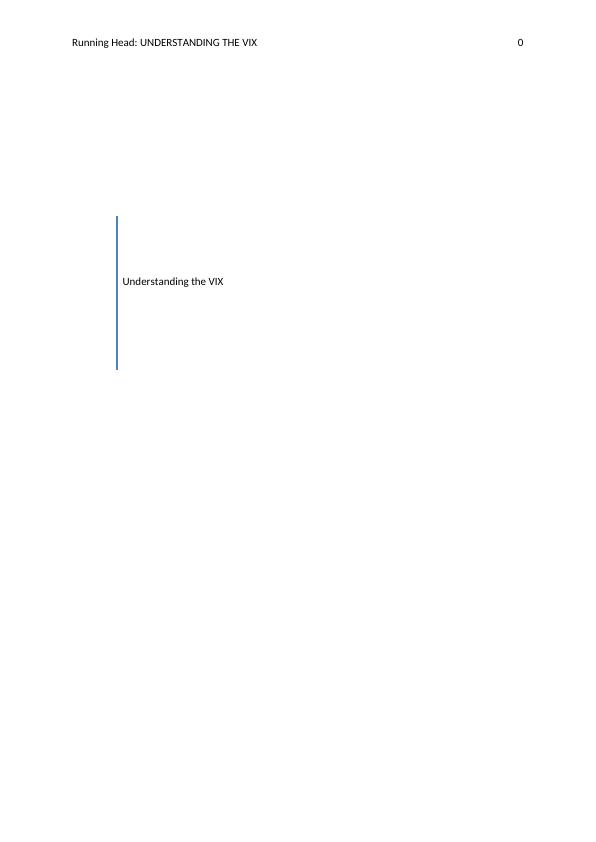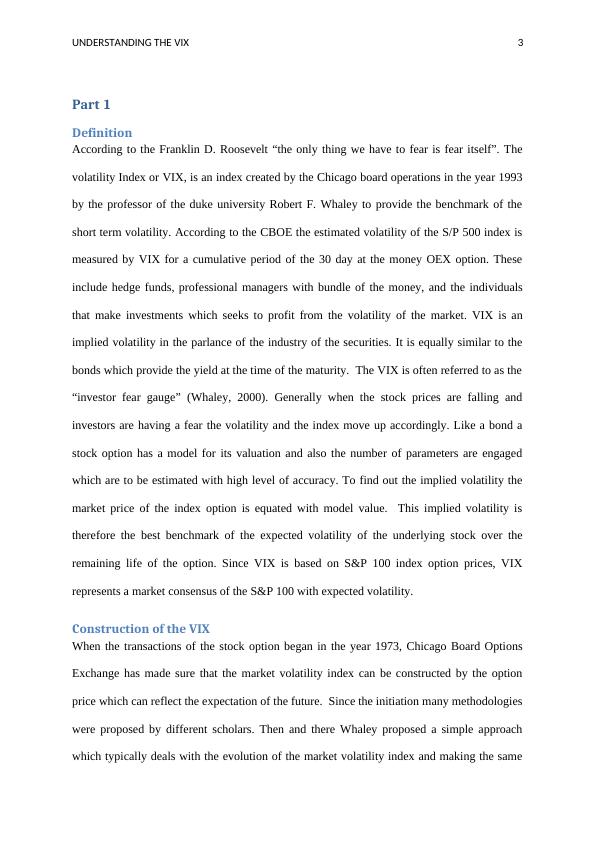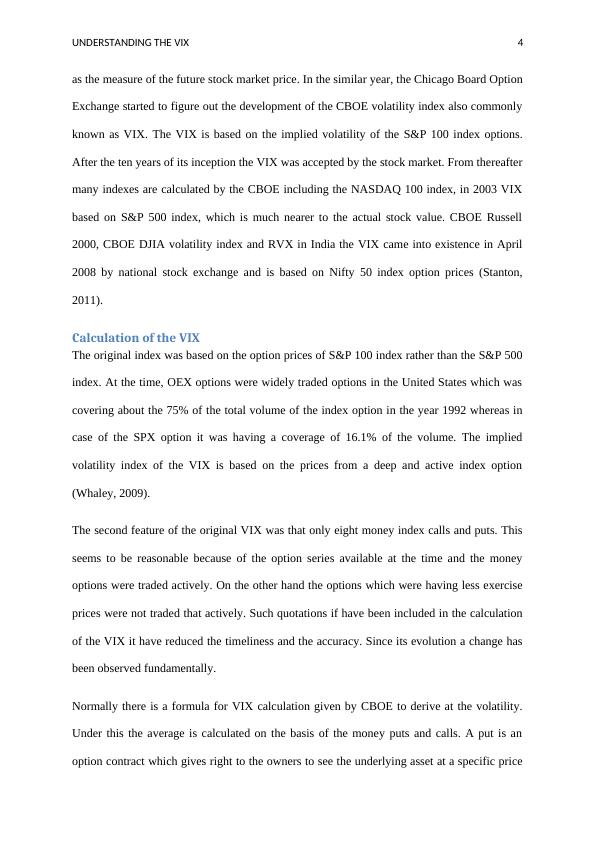Understanding the VIX
Added on 2023-06-11
21 Pages5556 Words426 Views
Running Head: UNDERSTANDING THE VIX 0
Understanding the VIX
Understanding the VIX

UNDERSTANDING THE VIX 1
Table of Contents
Part 1..........................................................................................................................................3
Definition................................................................................................................................3
Construction of the VIX.........................................................................................................3
Calculation of the VIX...........................................................................................................4
Step1...................................................................................................................................5
Step 2..................................................................................................................................6
Importance of the VIX for financial markets.........................................................................6
Part 2..........................................................................................................................................7
Reactive rather than predictive...........................................................................................8
Adjustments and allocations...............................................................................................8
Scaling Exposure................................................................................................................8
Variety and diversification..................................................................................................8
Maintaining a future perspective........................................................................................9
Part 3..........................................................................................................................................9
Exchange traded products linked to VIX...............................................................................9
Part 4........................................................................................................................................11
Short volatility Strategies.....................................................................................................11
How are they used to create the returns for the investors?...................................................12
Short selling......................................................................................................................12
Stock buy sell derivative multi strategy............................................................................13
Movements in stock..........................................................................................................13
Risks.........................................................................................................................................14
Skewed risk and reward Payoff........................................................................................14
Opposite sentiments..........................................................................................................14
Fundamental analysis........................................................................................................14
Government or economic reform strategies changes........................................................15
Table of Contents
Part 1..........................................................................................................................................3
Definition................................................................................................................................3
Construction of the VIX.........................................................................................................3
Calculation of the VIX...........................................................................................................4
Step1...................................................................................................................................5
Step 2..................................................................................................................................6
Importance of the VIX for financial markets.........................................................................6
Part 2..........................................................................................................................................7
Reactive rather than predictive...........................................................................................8
Adjustments and allocations...............................................................................................8
Scaling Exposure................................................................................................................8
Variety and diversification..................................................................................................8
Maintaining a future perspective........................................................................................9
Part 3..........................................................................................................................................9
Exchange traded products linked to VIX...............................................................................9
Part 4........................................................................................................................................11
Short volatility Strategies.....................................................................................................11
How are they used to create the returns for the investors?...................................................12
Short selling......................................................................................................................12
Stock buy sell derivative multi strategy............................................................................13
Movements in stock..........................................................................................................13
Risks.........................................................................................................................................14
Skewed risk and reward Payoff........................................................................................14
Opposite sentiments..........................................................................................................14
Fundamental analysis........................................................................................................14
Government or economic reform strategies changes........................................................15


UNDERSTANDING THE VIX 3
Part 1
Definition
According to the Franklin D. Roosevelt “the only thing we have to fear is fear itself”. The
volatility Index or VIX, is an index created by the Chicago board operations in the year 1993
by the professor of the duke university Robert F. Whaley to provide the benchmark of the
short term volatility. According to the CBOE the estimated volatility of the S/P 500 index is
measured by VIX for a cumulative period of the 30 day at the money OEX option. These
include hedge funds, professional managers with bundle of the money, and the individuals
that make investments which seeks to profit from the volatility of the market. VIX is an
implied volatility in the parlance of the industry of the securities. It is equally similar to the
bonds which provide the yield at the time of the maturity. The VIX is often referred to as the
“investor fear gauge” (Whaley, 2000). Generally when the stock prices are falling and
investors are having a fear the volatility and the index move up accordingly. Like a bond a
stock option has a model for its valuation and also the number of parameters are engaged
which are to be estimated with high level of accuracy. To find out the implied volatility the
market price of the index option is equated with model value. This implied volatility is
therefore the best benchmark of the expected volatility of the underlying stock over the
remaining life of the option. Since VIX is based on S&P 100 index option prices, VIX
represents a market consensus of the S&P 100 with expected volatility.
Construction of the VIX
When the transactions of the stock option began in the year 1973, Chicago Board Options
Exchange has made sure that the market volatility index can be constructed by the option
price which can reflect the expectation of the future. Since the initiation many methodologies
were proposed by different scholars. Then and there Whaley proposed a simple approach
which typically deals with the evolution of the market volatility index and making the same
Part 1
Definition
According to the Franklin D. Roosevelt “the only thing we have to fear is fear itself”. The
volatility Index or VIX, is an index created by the Chicago board operations in the year 1993
by the professor of the duke university Robert F. Whaley to provide the benchmark of the
short term volatility. According to the CBOE the estimated volatility of the S/P 500 index is
measured by VIX for a cumulative period of the 30 day at the money OEX option. These
include hedge funds, professional managers with bundle of the money, and the individuals
that make investments which seeks to profit from the volatility of the market. VIX is an
implied volatility in the parlance of the industry of the securities. It is equally similar to the
bonds which provide the yield at the time of the maturity. The VIX is often referred to as the
“investor fear gauge” (Whaley, 2000). Generally when the stock prices are falling and
investors are having a fear the volatility and the index move up accordingly. Like a bond a
stock option has a model for its valuation and also the number of parameters are engaged
which are to be estimated with high level of accuracy. To find out the implied volatility the
market price of the index option is equated with model value. This implied volatility is
therefore the best benchmark of the expected volatility of the underlying stock over the
remaining life of the option. Since VIX is based on S&P 100 index option prices, VIX
represents a market consensus of the S&P 100 with expected volatility.
Construction of the VIX
When the transactions of the stock option began in the year 1973, Chicago Board Options
Exchange has made sure that the market volatility index can be constructed by the option
price which can reflect the expectation of the future. Since the initiation many methodologies
were proposed by different scholars. Then and there Whaley proposed a simple approach
which typically deals with the evolution of the market volatility index and making the same

UNDERSTANDING THE VIX 4
as the measure of the future stock market price. In the similar year, the Chicago Board Option
Exchange started to figure out the development of the CBOE volatility index also commonly
known as VIX. The VIX is based on the implied volatility of the S&P 100 index options.
After the ten years of its inception the VIX was accepted by the stock market. From thereafter
many indexes are calculated by the CBOE including the NASDAQ 100 index, in 2003 VIX
based on S&P 500 index, which is much nearer to the actual stock value. CBOE Russell
2000, CBOE DJIA volatility index and RVX in India the VIX came into existence in April
2008 by national stock exchange and is based on Nifty 50 index option prices (Stanton,
2011).
Calculation of the VIX
The original index was based on the option prices of S&P 100 index rather than the S&P 500
index. At the time, OEX options were widely traded options in the United States which was
covering about the 75% of the total volume of the index option in the year 1992 whereas in
case of the SPX option it was having a coverage of 16.1% of the volume. The implied
volatility index of the VIX is based on the prices from a deep and active index option
(Whaley, 2009).
The second feature of the original VIX was that only eight money index calls and puts. This
seems to be reasonable because of the option series available at the time and the money
options were traded actively. On the other hand the options which were having less exercise
prices were not traded that actively. Such quotations if have been included in the calculation
of the VIX it have reduced the timeliness and the accuracy. Since its evolution a change has
been observed fundamentally.
Normally there is a formula for VIX calculation given by CBOE to derive at the volatility.
Under this the average is calculated on the basis of the money puts and calls. A put is an
option contract which gives right to the owners to see the underlying asset at a specific price
as the measure of the future stock market price. In the similar year, the Chicago Board Option
Exchange started to figure out the development of the CBOE volatility index also commonly
known as VIX. The VIX is based on the implied volatility of the S&P 100 index options.
After the ten years of its inception the VIX was accepted by the stock market. From thereafter
many indexes are calculated by the CBOE including the NASDAQ 100 index, in 2003 VIX
based on S&P 500 index, which is much nearer to the actual stock value. CBOE Russell
2000, CBOE DJIA volatility index and RVX in India the VIX came into existence in April
2008 by national stock exchange and is based on Nifty 50 index option prices (Stanton,
2011).
Calculation of the VIX
The original index was based on the option prices of S&P 100 index rather than the S&P 500
index. At the time, OEX options were widely traded options in the United States which was
covering about the 75% of the total volume of the index option in the year 1992 whereas in
case of the SPX option it was having a coverage of 16.1% of the volume. The implied
volatility index of the VIX is based on the prices from a deep and active index option
(Whaley, 2009).
The second feature of the original VIX was that only eight money index calls and puts. This
seems to be reasonable because of the option series available at the time and the money
options were traded actively. On the other hand the options which were having less exercise
prices were not traded that actively. Such quotations if have been included in the calculation
of the VIX it have reduced the timeliness and the accuracy. Since its evolution a change has
been observed fundamentally.
Normally there is a formula for VIX calculation given by CBOE to derive at the volatility.
Under this the average is calculated on the basis of the money puts and calls. A put is an
option contract which gives right to the owners to see the underlying asset at a specific price

UNDERSTANDING THE VIX 5
and a specific time. There is a belief in the mind of the buyer that the price will fall below the
exercise price before the expiry date. On the other hand the call is an option contract which
gives the right to the owners, but not the entire obligation to purchase a particular amount of
the asset at a specified price within a specified time. A call auction can also be referred to as
the call market (Whaley, 2013).
There are following steps to calculate the VIX index calculation
Step1
The money calls from the SPX and money puts form the SPX are cumulatively centred
together at the strike price of the money, determined by the K0. Only those options are
included in the calculation of the VIX index calculation which is of non-zero nature. Here the
important note that is to be taken care of or shall be considered is that as the volatility
escalates and falls down there is an expansion of the non-zero bids tends to expand and
contract eventually. Therefore the frequency of the variation is high as the number of options
may vary either on monthly, daily or minute to minute basis. Henceforth, the right selection is
important (Cboe volatility index, 2018).
Here under the contract month option, the forward SPX hall be determined and indicate it by
the alphabet F, by identifying the strike price to calculate the smallest absolute difference
between the call and the put prices.
Near term options Next term options
Strike Price Call Put Difference Strike Price Call Put Difference
1950
37.4
5 15.25 22.2 1950 41.05 18.9 22.15
and a specific time. There is a belief in the mind of the buyer that the price will fall below the
exercise price before the expiry date. On the other hand the call is an option contract which
gives the right to the owners, but not the entire obligation to purchase a particular amount of
the asset at a specified price within a specified time. A call auction can also be referred to as
the call market (Whaley, 2013).
There are following steps to calculate the VIX index calculation
Step1
The money calls from the SPX and money puts form the SPX are cumulatively centred
together at the strike price of the money, determined by the K0. Only those options are
included in the calculation of the VIX index calculation which is of non-zero nature. Here the
important note that is to be taken care of or shall be considered is that as the volatility
escalates and falls down there is an expansion of the non-zero bids tends to expand and
contract eventually. Therefore the frequency of the variation is high as the number of options
may vary either on monthly, daily or minute to minute basis. Henceforth, the right selection is
important (Cboe volatility index, 2018).
Here under the contract month option, the forward SPX hall be determined and indicate it by
the alphabet F, by identifying the strike price to calculate the smallest absolute difference
between the call and the put prices.
Near term options Next term options
Strike Price Call Put Difference Strike Price Call Put Difference
1950
37.4
5 15.25 22.2 1950 41.05 18.9 22.15

End of preview
Want to access all the pages? Upload your documents or become a member.
Related Documents
VIX and Its Significance in Risk Management and Derivativeslg...
|19
|5133
|345
Risk Management Derivativeslg...
|22
|5964
|110
Risk Management and Derivatives Assignmentlg...
|11
|1355
|51
Understanding VIX Futures and Optionslg...
|8
|2079
|312
US Stocks Suffer Worst Fall in 6 Years | Markets Volatilitylg...
|6
|1321
|270
Report on Investments and Portfolio Managementlg...
|9
|1922
|36
